Native Americans in film
The portrayal of Native Americans in film has been a systemic problem since the inception of the industry, employing harmful stereotypes that range from violent barbarians to noble and peaceful savages.[1] A variety of images appeared from the early to mid 1930s, and by the late 1930s negative images briefly dominated Westerns. In 1950, the watershed movie Broken Arrow appeared that many credit as the first postwar Western to depict Native Americans sympathetically. Starting in the 1990s, Native American filmmakers have attempted to make independent films that work to represent the depth and complexity of indigenous peoples as people and provide a realistic account of their culture.[1] However, much work remains to both include Native American stories in mainstream media and to cast indigenous actors for their parts in movies instead of their white counterparts, which speaks to the pervasive trend of whitewashing in Hollywood.
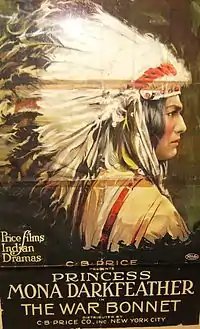
Whitewashing in Native American films
Whitewashing in film refers to the historic phenomenon stemming from the early 1900s where white actors have been cast for roles not meant for them. Instead of hiring someone that fits the intended race/ethnicity of the character, a white person is traditionally given that role. This is not unique to one racial or minority group; from Black, to Asian, and to Native American, many marginalised groups in America have felt the effects of whitewashing in the film industry.[2]
Whitewashing is two-pronged in effect, for not only does it impede Native American representation in film, but it also forces them into stereotypical roles.[3] The tropes of the savage Native American or the Native American at the mercy of white people have long been recycled for years. This allows Hollywood, a predominantly white industry from top to bottom, to continue to gatekeep access to coveted film roles. In 2017, roughly 70% of the characters in the top Hollywood releases for that year were white.[4] That year, roughly 60% of the US population was white, showing a disproportionate representation of white people in Hollywood.[5] This also reinforces many of the stereotypes many people possess regarding Native Americans, because there hasn't been a significant culture change as yet regarding how Native Americans are portrayed in mainstream American media. Furthermore, white actors have never faced a shortage of roles available to them in Hollywood, while Native Americans and other marginalized groups continue to experience this.[6]
History
- Early Native Americans in Film
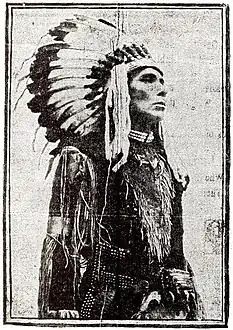 Dark Cloud (1855–1918), Native American film actor
Dark Cloud (1855–1918), Native American film actor Lillian Margaret St. Cyr (1873–1964), Native American film actress
Lillian Margaret St. Cyr (1873–1964), Native American film actress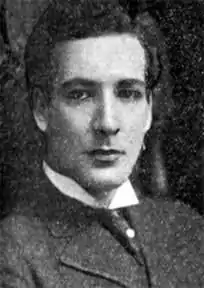 Edwin Carewe (1883–1940), the most prolific Native American director of feature films in Hollywood history
Edwin Carewe (1883–1940), the most prolific Native American director of feature films in Hollywood history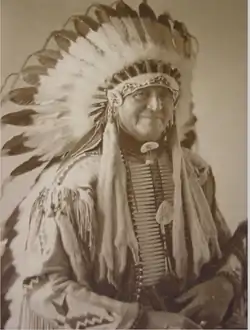 Luther Standing Bear (1868–1939), Native American film actor
Luther Standing Bear (1868–1939), Native American film actor

Dark Cloud, also known as Elijah Tahamont, was an Algonquin chief born in St. Francis Indian Village, Quebec, Canada who lived from 1861-1918. He starred in films such as What Am I Bid?(1919), The Woman Untamed (1920), The Birth of a Nation (1915) and The Dishonoured Metal (1914).[7]
Red Wing was born in 1884 to a Winnebago mother and French Canadian/Sauk father on the Winnebago Reservation in Nebraska. Early in her career, she starred in many small film roles. She was best known for starring in one of Hollywood's first Western films, The Squaw Man (1914). She was married to James Young Deer, another indigenous actor and director.[8]
Edwin Carewe, also known as Jay John Fox, was born in Gainesville, Texas, in 1883 to a white father and Chickasaw mother. An actor early in his career, Carewe started directing Hollywood films in 1914 during the silent era.[9] Some of his films include Ramona (1928), Evangeline (1929), Resurrection (1927), and Joanna (1925).
Luther Standing Bear, also known as Ota K'Te (Plenty Kill), was born on the Pine Ridge Reservation in South Dakota and lived from 1868-1939.[10] He is an Oglala Lakota writer and actor who started acting in 1912. Some of his filmography includes White Oak (1921), Cyclone of the Saddle (1935), and Union Pacific (1939).
James Young Deer was born James Young Johnson in Washington D.C. in 1876. He hails from the Nanticoke people of Delaware, and worked both as a director and actor. Some of his films include The Stranger (1920), The Great Secret (1917), and Lieutenant Daring RN and the Water Rats (1924).[11] From 1911-1914, James Young Deer was Head of Production/general manager for the Pathé Frères West Coast Studio located in Edendale, California. He was married to Native American actress Red Wing and passed away in 1946.
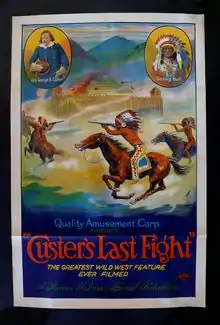
_-_Moving_Picture_World_1920.jpg.webp)
Early years
According to Beverly R. Singer, "Despite the fact that a diversity of indigenous peoples had a legal and historical significance in the formation of every new country founded in the Western Hemisphere, in the United States and Canada the term 'Indians' became a hegemonic designation implying that they were all the same in regards to culture, behavior, language, and social organization. Some critics viewed 'Indians' as savage and uncivilized in early films while others argued these movies showed a wide range of depictions of Native people from noble to sympathetic.[12]
Early films featuring Native characters varied in their depictions. Some of these characters were often shown wearing leather clothing with feathers in their hair or with elaborate feather headdresses. Authors have argued that Native communities were often depicted as cruel societies that sought out constant warfare and vengeance against white characters. But while some individual Native characters appeared as drunkards,cruel, or unintelligent, others were friends or allies to white settlers. A few successful Indian/white marriages did occur in film during these early years.[13] Other depictions were generalized stereotypes and used largely for aesthetic purposes and many tribes were represented. Feather headdresses were culturally and historically correct for approximately two dozen Plains tribes, and those of the American southwest were often wearing traditional clothing.[14]
Revisionist Western
The Revisionist Western, also known as a Modern Western or an Anti-Western, is a subgenre of Western films that began around the mid 1960s and early 1970s. This subgenre is characterized by a darker and more cynical tone that was generally not present in earlier Western films.
Revisionist Westerns featuring Native characters
- Two Rode Together (1961)
- The Deadly Companions (1961)
- Hombre (1967)
- Tell Them Willie Boy is Here (1969)
- Soldier Blue (1970)
- Little Big Man (1970)
- Chato's Land (1972)
- Jeremiah Johnson (1972)
- Buffalo Bill and the Indians (1976)
- The Missouri Breaks (1976)
- Dances With Wolves (1990)
- Thunderheart (1992)
- Dead Man (1995)
- The Missing (2003)
- The Only Good Indian (2009)
- The Lone Ranger (2013)
In the 1970s, Revisionist Westerns like Little Big Man and Soldier Blue often portrayed Native Americans as victims and white people as the frontier's aggressive intruders.[15] While the studio comedy Little Big Man still centers on a white protagonist, Dustin Hoffman, the Native Americans are depicted sympathetically while members of the United States Cavalry are depicted as villains. The Cheyenne in the film are living harmoniously and peacefully at the start of the film, and it's the encroachment of the violent white men who are the harmful, disruptive influence on their culture and landscape.[16] The film is also noted for including a Two-Spirit character as well as showing Lt. Colonel George Armstrong Custer as a lunatic – a fool and a fop – whom the white protagonist betrays for the sake of his adopted Indian family.[16]
The 1980s saw the emergence of an independent film with contemporary Native content such as Powwow Highway, a road movie and buddy film where one protagonist, an angry young activist, namechecks the American Indian Movement while the other visits sacred sites to greet the dawn. Both are on their way to free a friend from jail.[17] George Harrison was the movie's executive producer.
1990's Dances with Wolves, while hailed by mainstream audiences and providing jobs for many Lakota actors, has also been cited as a return to the White savior narrative in film.[18] In the film U.S. soldiers capture John Dunbar (Kevin Costner) and take him as a prisoner. Native Americans race onto the scene and kill all of the U.S. soldiers while none of the Native Americans appear to have been killed. Some of them receive injuries, but they are portrayed as strong and immune to the pain. However, Dunbar then becomes part of the tribe and leads the Sioux against their rivals, the Pawnee, and later helps them escape the same army he once served. The final credits of the film suggest that Sioux people are now extinct, which a few criticized.[19]
Also in the 1990s, a few Native American filmmakers wrote, produced, and directed their own projects such as Chris Eyre's 1998 film, Smoke Signals, which has been selected for preservation in the National Film Registry for being "culturally, historically, or aesthetically significant".[20] It is one of few films featuring Native American characters and directed by a Native filmmaker (along with Edwin Carewe's early movies) that received theatrical distribution.[21] Smoke Signals was written, directed, and acted in by Native Americans.[21] Like Powwow Highway, it is also a road movie and buddy film that examines friendship, fatherhood, and the roles of tradition versus modernity in Indian Country.[22]
The New World offers a largely fictionalized retelling of the relationship between John Smith and Pocahontas. John Smith arrives to the Americas with the Pilgrims and is immediately captured by a Native American tribe. The movie did offer several myths about Pocahontas, changing her into an adult so the film can be made into a love story. In reality, Pocahontas was a child of about ten she met John Smith, and most scholars agree that some of the events in the movie ever took place.[23][24]
Directed by Anthony Mann, the 1950 Western "Winchester '73" tells the story of a stolen Winchester rifle and the efforts to retrieve it. One of the main characters in the film is a Native American, played by the well-known white Hollywood actor Rock Hudson. Hudson was prominent during the 50s and 60s during Hollywood's Golden Age.[25]
"The Outsider" is a 1961 biopic film directed by Delbert Mann about the life of Ira Hayes, a Native American World War II veteran who served in the United States Marine Corps. Hayes was part of the group that raised the U.S. flag on Iwo Jima. Although Hayes was Native American, he is played by Tony Curtis, a white actor with Hungarian roots.[25]
Peter Tewksbury's 1968 comedy Western film "Stay Away, Joe" sees Elvis Presley play Joe Lightcloud, a Navajo man. The film is based on the book of the same name by Dan Cushman, and is about Lightcloud's efforts along with his father to prove to their local congressman that they can raise cattle on their reservation.[25]
"The Last Airbender" is a 2010 film directed by M. Night Shyamalan. It is based on the anime series with Asian and Native American characters, but the film features several white actors in prominent roles.[25]
Johnny Depp was cast as Tonto in the 2013 film "The Lone Ranger", directed by Gore Verbinski. Although Depp is white, the Comanche Nation formally adopted him and gave him an honorary title and membership in 2012.[25]
In "Aloha" (2015) directed by Cameron Crowe, actress Emma Stone, one of the highest paid and most prominent actresses in the film industry, plays the protagonist who has a Native American parent.[25]
"Pan", a 2015 film directed by Joe Wright, cast Rooney Mara as Tiger Lily, the Native American princess from Peter Pan.[25]
Native Americans in animation
- Peter Pan (1953): Peter Pan is a 1953 animated film produced by Walt Disney. A major scene in Peter Pan involves the Darling children, Wendy, John and Michael Darling, the Lost Boys and Peter Pan celebrating at the Indian camp after Peter rescues Tiger Lily, the daughter of the chief, from Captain Hook and Mr. Smee. This scene features the song, "What Makes the Red Man Red?"
- Pocahontas (1995): Pocahontas is a 1995 Disney animated film. In this film, John Smith, while on the a voyage to Jamestown encounters Pocahontas and the Powhatan tribe. Conflict between the European settlers and Native Americans ensues, as tension ratches up between the two groups over land. Before a battle between the two groups begins, Pocahontas saves the life of John Smith and prevents the war. Though presented as historical, the story is highly fictionalised.
- Brother Bear (2003): Brother Bear is a 2003 animated film produced by Disney that follows the story of an Inuit boy named Kenai as he pursues the bear that killed his older brother, Sitka. However, his vengeance against the bear angers the Spirits. As punishment, the Spirits transform Kenai into a bear. In order to be human again, Kenai must travel to a mountain where the Northern lights touch the earth.
- Molly of Denali (2019): Molly of Denali is an animated series following the adventures of Molly, a 10-year-old Alaska Native, her friends Tooey and Trini, and her dog Suki. Molly of Denali is the first nationally distributed children's to feature an Alaska Native as the main character and protagonist.[26]
Documentaries
- Broken Rainbow (1985): Broken Rainbow details the forced relocation of the members of the Navajo tribe from Black Mesa, Arizona after the 1974 Navajo-Hopi Land Settlement Act.[27] Many Navajo families were separated during this period of displacement in the U.S. government's attempt to ameliorate perceived issues between the Hopi and Navajo tribes.[28] This documentary underscores several issues that indigenous communities across the United States face today; the growing desire to acquire indigenous lands for capitalist ventures. At stake are mining rights, land boundaries, and extraction for uranium, gas, oil, and other raw materials. Directed by Victoria Mudd, it won the Academy Award for Best Documentary in 1986.[29] The cast includes the voice narrations of Martin Sheen, Buffy Sainte-Marie, Burgess Meredith, and others.
- Imagining Indians (1992): Imagining Indians is a 1992 documentary film produced and directed by Native American filmmaker, Victor Masayesva, Jr. (Hopi). The documentary attempts to reveal the misrepresentation of Indigenous culture and tradition in Classical Hollywood films through interviews with different Native actors and extras from various tribes throughout the United States.[30] It stars Shirley Atene, Karmen Clifford, Marvin Clifford, and others.[31] The cast is entirely Native American, pulling indigenous people from the Amazon, Montana, Arizona, and other places. It is considered one of Masayesva's more provocative pieces of cinema, as it delves into the complexities surrounding white perception of Native American culture and identity. The film also touches upon the invasive nature of Hollywood in terms of filming on reservations. Director Masayesva said that The Dark Wind (1991) intruded on his village to film when he was younger, and he felt the duty to share stories like these with the outside world.[32]
- The Canary Effect (2006): The Canary Effect is an examination of the effects of the United States and its policies on Indigenous communities.[33] Some of these policies include forced schooling of children outside Native American communities, mass killings, forced female sterilisation, and more. It was directed by Robin Davey, a British musician, and Yellow Thunder Woman, who hails from the Yankton Sioux and Rosebud Sioux reservations of South Dakota.[34] Both of them are members of the LA pop group The Bastard Fairies. The film first premiered at the Tribeca Film Festival in New York, and in 2006 it won the Stanley Kubrick Award at the Traverse City Film Festival in Michigan.[35] The cast includes Charles Abourezk and Ward Churchill, author, former professor, and one of the leaders of the American Indian Movement of Colorado since the 1980s.[36]
- Reel Injun (2009): Reel Injun is a 2009 Canadian documentary film directed by Cree filmmaker Neil Diamond, Catherine Bainbridge, and Jeremiah Hayes that explores the portrayal of Native Americans in film. Reel Injun is illustrated with excerpts from classic and contemporary portrayals of Native people in Hollywood movies and interviews with filmmakers, actors and film historians, while director Diamond travels across the United States to visit iconic locations in motion picture as well as American Indian history.[37] The documentary chronicles the journey of Native Americans in film over roughly a century, with particular attention on the transition from the silent era of Hollywood to today.[38] It utilises clips from different eras of film, and Diamond meets with famous filmmakers such as Clint Eastwood to learn more about the transformation of the Native American image onscreen. Other cameos include Robbie Robertson (soundtrack composer), Graham Greene (Native American actor), Wes Studi (Native American actor), Jim Jarmusch (filmmaker), and Chris Eyre (filmmaker). Diamond heads to famous locations such as Monument Valley, where many Westerns were filmed, and South Dakota's Black Hills, the home of several notable Native Americans.
- Inventing the Indian (2012): Inventing the Indian is a 2012 BBC documentary, initially broadcast on 28 October 2012, that explores the stereotypical view of Native Americans in the United States in cinema and literature.[39] Directed by Chris Cottam, the documentary is presented by Rich Hall, a British comedian. The cast also includes Dave Bald Eagle, Ailema Benally, and Milton Bianis.[40] Hall attempts to dismantle some of the pervasive stereotypes that beleaguer the Native American community to this day by heading to indigenous areas in Arizona, South Dakota, and other places as well. He examines the way Native Americans have been portrayed on screen in movies such as Soldier Blue and A Man Called Horse, while also looking at literary representations of indigenous peoples, in books like The Last of the Mohicans and Bury My Heart at Wounded Knee.[41]
Prominent Native American Actors
Wes Studi, born in 1947 in Oklahoma, is a Cherokee actor and professional horse trainer known for starring in over 80 films. Some of his work includes Dances with Wolves (1990), The Last of the Mohicans (1992), and Avatar (2009).[42] He is credited with bringing versatile and masterful performances into Hollywood which have helped to dismantle some of the stereotypes surrounding Native Americans within the industry. In 2019, Studi received the Governors Award, an honorary award that commemorates the lifetime performance of an actor each year. Studi is just the second actor to receive an award for performances in film, following Ben Johnson in 1972.[43]
Born in South Dakota, Russell Means was an Oglala Lakota Sioux Native American who lived from 1939-2012.[44] Means was the first director of the American Indian Movement, which was originally created to fight poverty and police brutality amongst American indigenous communities. He fought for the rights of indigenous people worldwide, and is known for giving a televised speech in 2000 where he said he prefers the label 'Indian' to 'Native American' because everyone born in the United States should be considered a Native American.[45] He also ran an unsuccessful presidential campaign in 1987 as a member of the Libertarian party. He has starred in films such as The Last of the Mohicans (1992), Natural Born Killers (1994) and Pocahontas (1995).
Will Sampson, from Oklahoma, was a member of the Creek Nation that lived from 1933-1987.[46] He received his big acting break with the role "Chief" Bromden in One Flew Over the Cuckoo's Nest (1975), one of only three movies to win the Big Five Academy Awards. Sampson was also known for starring in films such as The Outlaw Josey Wales (1976), Orca (1977), and The White Buffalo (1977). After passing away in 1987, he was buried on the reservation that he grew up on.
Julia Jones, born in 1981, is an actress from Boston, Massachusetts. She comes from a multiracial background, having Choctaw and Chickasaw ancestry along with English and African-American roots.[47] She has starred in films such as Black Cloud (2004), Jonah Hex (2010), and The Twilight Saga (2010-2012), along with the TV series Westworld (2018) and The Mandalorian (2019). Jones, who has successfully landed roles in several major films, has used her voice and platform to speak out about the lack of Native American representation in cinema, and has called for greater inclusion of Native American actors in these spaces.
Floyd Westerman, who also went by 'Red Crow', was a Dakota Sioux actor, activist and musician born in 1936 on the Lake Traverse Indian Reservation in Roberts County, South Dakota.[48] He starred in Dances with Wolves (1990), Dharma & Greg (1997), and Hidalgo (1994). Outside of film, Westerman has used his musical talents to bring greater awareness to issues facing indigenous people in the United States. He collaborated with artists such as Sting, Willie Nelson, and Don Henley to achieve such goals. He was also an ambassador for the International Indian Treaty Council, a multinational organization striving for the self-determination and autonomy of indigenous peoples across the world. He passed away in 2007.
See also
References
- Boyd, Julia (Spring 2015). "An Examination of Native Americans in Film and Rise of Native Filmmakers" (PDF). The Elon Journal of Undergraduate Research in Communications. 6: 105–111.
- "Whitewashing in film", Wikipedia, 2020-10-05, retrieved 2020-12-09
- Beach, Adam (2017-09-14). "'Suicide Squad's Adam Beach On Why Casting Of Others For Native American Roles Is So Hurtful". Deadline. Retrieved 2020-12-09.
- Salam, Maya (2018-08-02). "Hollywood Is as White, Straight and Male as Ever (Published 2018)". The New York Times. ISSN 0362-4331. Retrieved 2020-12-09.
- "U.S. Census Bureau QuickFacts: United States". www.census.gov. Retrieved 2020-12-09.
- Brook, Tom. "When white actors play other races". www.bbc.com. Retrieved 2020-12-09.
- "Dark Cloud". IMDb. Retrieved 2020-12-09.
- "Red Wing". IMDb. Retrieved 2020-12-09.
- "Edwin Carewe was pioneering director during silent screen era | Chickasaw Times". chickasawtimes.net. Retrieved 2020-12-09.
- "Luther Standing Bear - Akta Lakota Museum & Cultural Center". aktalakota.stjo.org. Retrieved 2020-12-09.
- "James Young Deer". IMDb. Retrieved 2020-12-09.
- Beverly R. Singer: Native Americans and Cinema. In: Barry Keith Grant (ed. in chief): Schirmer Encyclopedia of Film: Volume 3: Independent Film–Road Movies. Farmington Hills, MI: Schirmer Reference, 2007, pp. 211–214, [212]. Angela Aleiss, Making the White Man's Indian" Native Americans and Hollywood Movies, (2005), Praeger Publishers.
- Price, John A. (1973). "The Stereotyping of North American Indians in Motion Pictures". Ethnohistory. 20 (2): 153–171. doi:10.2307/481668. ISSN 0014-1801. JSTOR 481668.
- Price, John A. (1973). "The Stereotyping of North American Indians in Motion Pictures". Ethnohistory. 20 (2): 153–171. doi:10.2307/481668. ISSN 0014-1801. JSTOR 481668. Angela Aleiss, Making the White Man's Indian" Native Americans and Hollywood Movies, (2005), Praeger Publishers.
- Aleiss, Angela (2005). Making the White Man's Indian: Native Americans and Hollywood Movies. Praeger Publishers. pp. 1–57, 119–140.
an indian love story 1911.
- Rollins, Peter (2011). Hollywood's Indian: The Portrayal of the Native American in Film. University Press of Kentucky. pp. 121–136. ISBN 978-0813131658.
- Ebert, Roger, "Powwow Highway" for the Chicago Sun-Times. 28 April 1989. Archived at Digital Chicago, Inc.
- Goff, Keli (May 4, 2014). "Can 'Belle' End Hollywood's Obsession with the White Savior?". The Daily Beast. Retrieved May 14, 2014.
- Dances with Wolves. Dir. Kevin Costner. Tig Productions. Orion Pictures, 1990. Film.
- "'Jurassic Park', 'Shining' added to National Film Registry". Associated Press. December 12, 2018. Retrieved December 12, 2018.
- Domínguez, Daisy (2014). "American Indians in Feature Films: Beyond the Big Screen". CUNY Academic Works.
- Thomas, Kevin (26 June 1998). "Smoke Signals: Stylish 'Signals' a Bittersweet Comedy About Friendship". Los Angeles Times. Retrieved 11 April 2018.
- "A Guide to Writing about Virginia Indians and Virginia Indian History" (PDF). Commonwealth of Virginia, Virginia Council on Indians. January 2012. Archived from the original (PDF) on February 24, 2012. Retrieved April 18, 2019.
- The New World. Dir. Terrence Malick. New Line Cinema, 2006.
- Simons, Meredith. "100 times a white actor played someone who wasn't white". Washington Post. ISSN 0190-8286. Retrieved 2020-12-09.
- "PBS KIDS Announces MOLLY OF DENALI, Premiering July 15, 2019". PBS About. Retrieved 2019-11-18.
- Goodman, Walter (1986-04-11). "Film: 'Broken Rainbow', Documentary". The New York Times. ISSN 0362-4331. Retrieved 2019-11-18.
- "THE IMPACT OF THE NAVAJO-HOPI LAND SETTLEMENT ACT OF 1974 P.L. 93-531 et al" (PDF).
- Mudd, Victoria (1987-07-18), Broken Rainbow (Documentary, History), Martin Sheen, Buffy Sainte-Marie, Burgess Meredith, Laura Nyro, Earthworks Films, retrieved 2020-12-09
- "Imagining Indians". Documentary Educational Resources Online Store. Retrieved 2019-11-18.
- Jr, Victor Masayesva, Imagining Indians (Documentary), Shirley Atene, Karmen Clifford, Marvin Clifford, Avis Little Eagle, retrieved 2020-12-09
- "Imagining Indians (1992)".
- "The Canary Effect | Tribeca Film Festival". Tribeca. Retrieved 2019-11-18.
- "The Canary Effect | 2006 Tribeca Film Festival". Tribeca. Retrieved 2020-12-09.
- The Canary Effect, retrieved 2020-12-09
- Davey, Robin; Woman, Yellow Thunder (2006-04-27), The Canary Effect (Documentary), Charles Abourezk, Ward Churchill, Weapons of Mass Entertainment, retrieved 2020-12-09
- "Reel Injun: Native Americans Portrayal in Hollywood". Independent Lens. PBS. Retrieved 2019-11-18.
- "Reel Injun | Native Americans Portrayal in Hollywood | Independent Lens | PBS". Independent Lens. Retrieved 2020-12-09.
- "BBC Four - Rich Hall's Inventing the Indian". BBC. Retrieved 2019-11-18.
- Cottam, Chris (2012-10-28), Rich Hall's Inventing the Indian (Documentary, History, Western), Rich Hall, Dallas Goldtooth, Dave Bald Eagle, Ailema Benally, Open Mike Productions, retrieved 2020-12-09
- www.bbc.co.uk https://www.bbc.co.uk/programmes/b01nqbqk. Retrieved 2020-12-09. Missing or empty
|title=(help) - "Wes Studi". IMDb. Retrieved 2020-12-09.
- Appelo, Tim. "Oscars Honor Actor Wes Studi for Lifetime Achievement". AARP. Retrieved 2020-12-09.
- "Russell Means". IMDb. Retrieved 2020-12-09.
- "Native American vs. American Indian: Political correctness dishonors traditional chiefs of old". nativetimes.com. Retrieved 2020-12-09.
- "Will Sampson". IMDb. Retrieved 2020-12-09.
- "Julia Jones". IMDb. Retrieved 2020-12-09.
- "Floyd 'Red Crow' Westerman". IMDb. Retrieved 2020-12-09.
Further reading
- Native Americans on Network TV (2013)
- Aleiss, Angela (2005). Making the White Man's Indian: Native Americans and Hollywood Movies. Westport, Conn./London: Praeger. ISBN 0-275-98396-X.
- Simmon, Scott (June 30, 2003). The Invention of the Western Film: A Cultural History of the Genre's First Half Century. New York: Cambridge University Press. ISBN 0-521-55581-7.
- Liza Black. 2020. Picturing Indians: Native Americans in Film, 1941-1960. University of Nebraska Press.